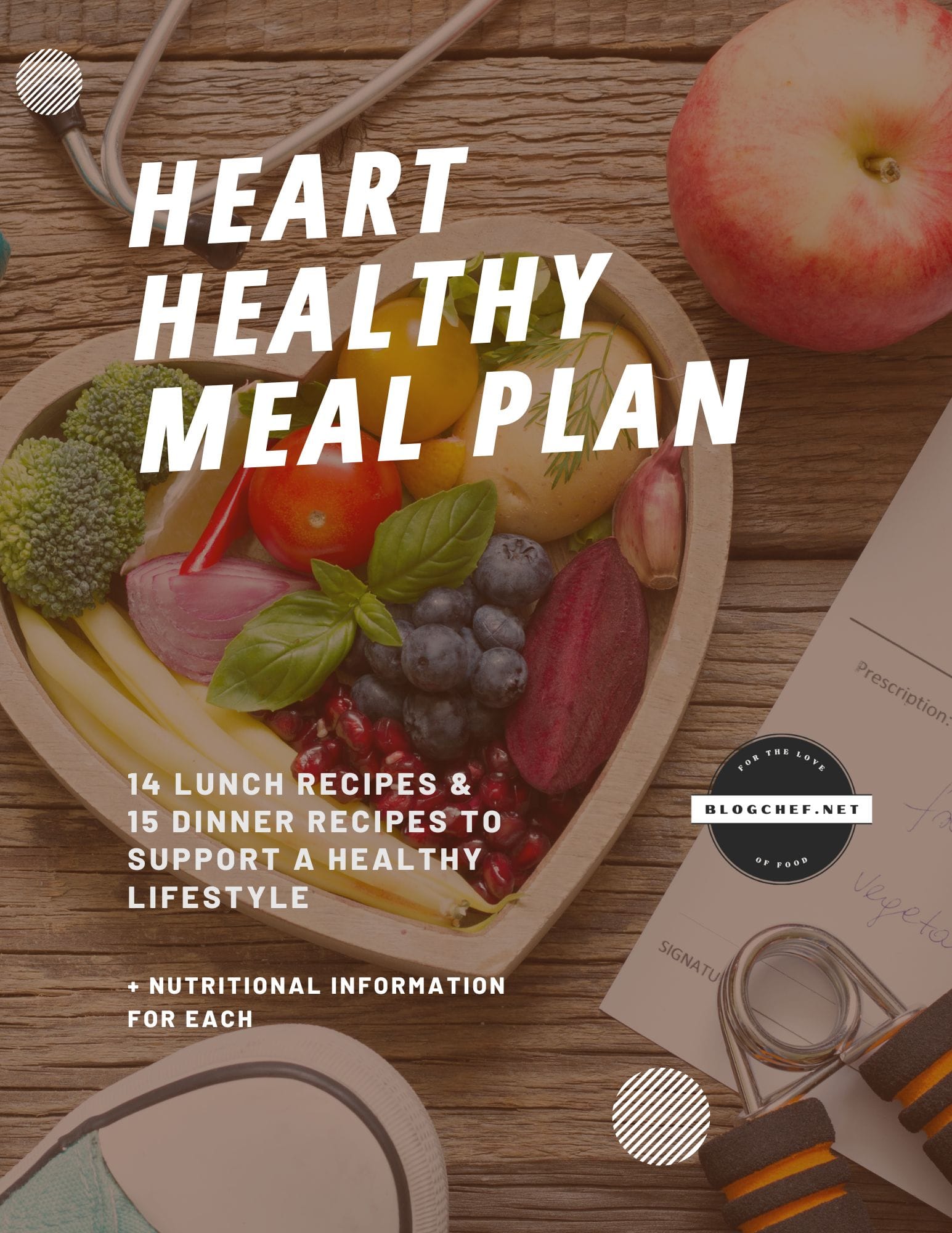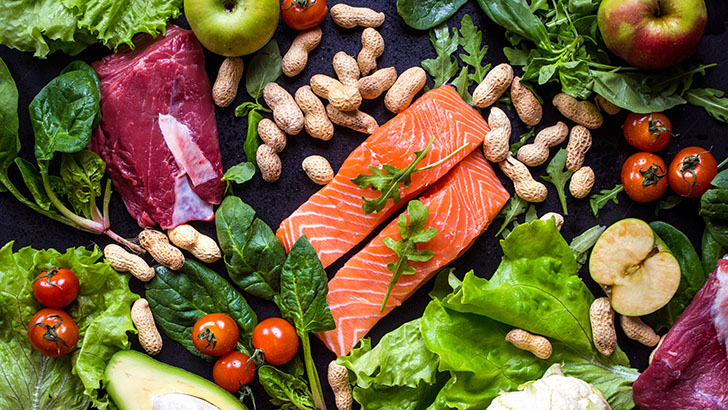This 30-day heart-healthy meal plan includes wholesome, nutritious foods known to boost your heart health. You know, the good stuff: Nutrient-packed veggies, fiber-rich whole grains, lean protein, healthy fats, and lots of plant-based protein options.
Your heart is a critically important body part, so taking care of it should be a top health priority. One thing anyone can do to care for their heart is make smart food choices that lower LDL and saturated fat. This meal plan is designed to help you do just that.
Benefits of eating right
According to the Centers for Disease Control and Prevention (CDC), these are some of the benefits of healthy eating:
- Longer lifespan
- Healthier skin, eyes, muscles, and bones
- Reduced risk of heart disease, type 2 diabetes, and some cancers
- Better digestion
Living longer
According to Harvard Medical School, not eating enough fruits, vegetables, and fiber raises your risk of potentially life-threatening conditions, including obesity, hypertension, diabetes, and cardiovascular disease.
A nutritious diet also generally strengthens your immune system, so you’re better equipped to fight against potentially dangerous health problems — like flu and COVID. As an example, Vitamin B6 (found in eggs, milk, salmon, carrots, and spinach) helps your body fight infections. You can get it from a healthy diet or by taking a vitamin b6 supplement.
Healthier skin, eyes, muscles, and bones
Fruits, vegetables, whole grains, lean proteins, and unsalted nuts provide a variety of nutrients that support other systems in your body — including your skin, eyes, and muscles.
A healthful diet that includes sources of calcium, Vitamin D, magnesium, Vitamin K, and trace minerals like silicon also strengthens your bones and wards off osteoporosis.
Reduced risk of heart disease
High-fat, high-sugar, and high-sodium diets take a toll on your body overall, especially your heart. Eating a variety of nutritious foods reduces the strain on your heart and ultimately lowers your risk of heart disease.
Better digestion
Fruits and vegetables are rich in fiber, which benefits your digestion in several ways. Fiber gives you that satisfying “full” feeling, which can reduce cravings for sugary or salty foods. Fiber also supports nutrient absorption, keeps you regular, and lowers your risk of serious gut conditions.
Heart-healthy eating plan overview

The plan follows the heart-healthy guidelines from Mayo Clinic and American Heart Association in terms of limiting red meat, refined sugars, sodium, and foods that are high in saturated fat or trans fat. Instead, the plan incorporates fruits, vegetables, beans, nuts, lean meats, low-fat dairy foods, and fish that’s rich in omega-3 fatty acids. Eating oily fish once a week helps protect your heart and lower the risk of heart disease.
Keep in mind that the best foods for heart health are usually colorful and high in fiber. Look for fresh foods that are dark red, blue, orange, or green, such as raspberries, blueberries, carrots, spinach, and peas.
The lunch and dinner recipes below are available in our heart-healthy eating plan download.
15 heart-healthy breakfasts
- Avocado egg toast (smash half an avocado on toast and place a poached egg on top)
- Bran cereal with fat-free milk
- Nonfat plain Greek yogurt mixed with a teaspoon of vanilla extract
- Rolled oats cooked skim milk, topped with cinnamon
- Bowl of Cheerios with fresh berries and almond milk
- Whole wheat pancakes with strawberries (try Kodiak pancake mix)
- Sweet potato hash (cube sweet potatoes and boil them until soft, then fry them up with onions, zucchini, and bell peppers with a tiny bit of oil)
- Whole wheat breakfast burrito (scrambled egg whites with onions and peppers, wrapped in a whole wheat tortilla)
- Fruit and granola bowl (mix sliced fruit, plain yogurt, and granola)
- Bran cereal with bananas and blueberries
- Microwaved sweet potato topped with diced apple and maple syrup (for sweetness in lieu of added sugar)
- Scrambled tofu on toast (saute tofu and spinach and serve on toast — add a splash of salsa if you like things spicy)
- Ricotta and berries on whole grain toast
- Oatmeal, topped with bananas and berries
- Peanut butter and banana smoothie made with almond milk
You can put your own spin on these healthy breakfast ideas to add more variety. For example, you can make a smoothie out of numerous combinations of fruit and yogurt or almond milk. Adding tofu or frozen banana also gives your smoothie a satisfying, creamy texture. You can also try different toppings on oatmeal, cereal, and yogurt.
15 heart-healthy snacks
- Any fresh berry
- Unsalted almonds or cashews
- Air-popped popcorn
- Carrot sticks
- Apple with almond butter
- Rice cakes topped with jam
- Whole grain crackers with tuna
- Zucchini sticks with hummus
- Homemade coffee smoothie made with almond milk and almond butter
- Fruit salad with a dollop of plain yogurt
- Edamame
- Red grapes, fresh or frozen
- Lox and whole-grain crackers
- Oven-roasted kale chips
- Cubed watermelon, berries, and fresh mint
- Homemade healthy granola
For more snack ideas, see: quick and healthy snacks for energy and productivity.
15 heart-healthy lunches
The lunch and dinner recipes below are available in our heart-healthy eating plan download.

- Black bean soup
- Spinach and strawberry salad
- Homemade wholegrain pasta salad with broccoli, sun-dried tomatoes, fresh herbs, and low-fat salad dressing
- Blackened chicken, cherry tomato, and romaine salad
- Chicken cauliflower fried rice
- Tuna, white bean, and dill salad
- Cucumber, carrot, and spring mix sandwich with hummus on whole wheat toast
- Grilled shrimp and avocado tacos on corn tortillas
- Homemade tomato soup (roast tomatoes, onions, garlic in oven, add to hot, low-sodium chicken broth, and blend)
- Arugula salad with vinaigrette and rotisserie chicken
- Miso soup
- Mexican lettuce wraps (saute chicken, onion, bell pepper, top with salsa, and serve in lettuce cups)
- Kale, apple, almond salad
- Homemade turkey pumpkin chili
15 heart-healthy dinners
- Seared salmon with garlic green beans
- Grilled shrimp with pesto, served on whole grain pasta
- Curried sweet potato soup
- Pork tenderloin with roasted vegetables
- Baked butternut squash stuffed with turkey sausage
- Asian meatballs with cauliflower rice
- Skillet lemon chicken with potatoes and kale
- Toaster oven tostada
- Chicken black bean taco salad
- Cauliflower leek soup with whole-grain crackers or brown rice
- Stuffed zucchini with tofu cheese (tofu cheese is a good alternative for those looking to reduce cholesterol)
- Roasted chicken breast with Greek salad
- Seared steak salad
- Healthy Kung Pao chicken
- Chinese chicken skewers with whole grain rice and roasted zucchini
You can add to your healthy lunch and dinner options with recipes from our healthy salad round-up.
What not to eat on a heart-healthy diet
On your healthy-eating journey, it’s wise to cut back on foods like:
- White foods you eat, such as white rice, bread, and potatoes
- Packaged and processed snacks — these are often high in trans fat
- Foods with high sodium and saturated fat
- Baked goods
- High-fat foods like red meat and cheese
- Processed meats like lunch meat or sausage, which can be high in sodium
Extra tips
- Make sure your pantry is filled with nutritious ingredients. See the shopping list below for heart-healthy eating ideas.
- Please take note of your calorie intake when on this plan, and try not to overshoot it.
- A well-rounded exercise program can complement this diet.
- Consult your health care professional before commencing on this meal plan or any new exercise regiment to rule out any medical conditions.
Shopping list to stock your pantry
Whole grains/High fiber starches
- Whole wheat bread or bagels
- Couscous
- Quinoa
- Whole-grain pasta and rice
- Oatmeal
- Bulgur
- Sweet potato
- Yam
- Winter squashes
- Green peas
- Corn
Proteins
- Poultry — chicken and turkey
- Skinless ground turkey and chicken
- Precooked grilled chicken strips
- Low-sodium, low-fat deli turkey/chicken/ham
- Salmon
- Mackerel
- Sardine
- Pork tenderloin
- Tofu
- Low-fat cheese
- Fat-free milk, almond milk, or soy milk
- Canned beans
- Lentils
- Legumes
- Hummus
- Natural unsalted peanut butter
- Almond butter
- Eggs
Vegetables
- Spinach
- Kale
- Cauliflower
- Lettuce
- Broccoli
- Zucchini
- Red bell pepper
- Onion
Fresh fruits
- Raspberries
- Blueberries
- Apples
- Bananas
- Orange
- Avocado
- Tomato
Fats and cooking oil
- Olive oil
- Canola oil
- Grape seed oil
- Peanut
- Soybean
- Sunflower
- Avocado oil
Snacks, cooking ingredients, and dressings
- Unsalted nuts
- Unsweetened dried fruits (like mango)
- Low-fat or light mayonnaise
- Oil-based salad dressings like balsamic vinaigrette
- Yogurt
Your 30-day heart-healthy meal plan
You know what they say: You are what you eat. Your diet plays a huge part in keeping your heart healthy.
To give yourself a good shot at sticking to your 30-day heart-healthy program, stock your pantry and refrigerator with nutritious foods you love. Once you identify healthful foods you love, it’ll be easy to stick with your plan. After an adjustment period, you’re guaranteed to feel more energetic, too.
More healthy meal plans
See these healthy meal plans for more ideas for eating right:
